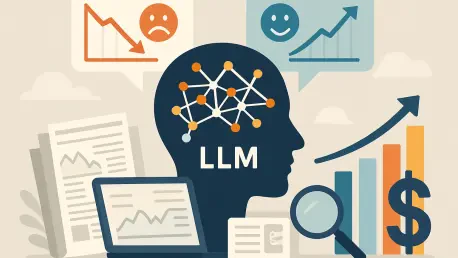In an era where economic policymaking is increasingly intertwined with technological innovation, the emergence of Large Language Models (LLMs) marks a transformative shift in how vast troves of unstructured textual data are interpreted. These sophisticated tools, capable of dissecting the nuanced language in central bank reports, are providing economists and policymakers with unprecedented insights into economic conditions and sentiments that traditional numerical models often fail to capture. By analyzing documents from institutions like the Bank of England and the Bank of Japan, LLMs reveal the subtle ways in which global shocks are perceived and communicated across different regions and historical moments. This approach goes beyond mere numbers, tapping into the rich narratives embedded in policy texts to uncover hidden drivers behind economic events. From the fallout of the Global Financial Crisis to more recent challenges like energy price surges, the application of sentiment and topic analysis through LLMs offers a fresh perspective on economic storytelling. This exploration delves into the groundbreaking methods behind this technology, highlights the unique revelations it brings to light, and addresses the hurdles of ensuring precision in such a complex domain. For anyone intrigued by the fusion of language processing and economic analysis, this discussion promises a compelling journey through a blend of data-driven insights and contextual understanding, reshaping how global economic phenomena are understood and acted upon.
Harnessing Language Models for Economic Insights
The integration of LLMs, such as those developed by leading tech innovators, into economic analysis represents a significant leap forward in deciphering the dense, often intricate textual data found in central bank documents. Unlike older lexicon-based approaches that struggled with the subtleties of language, these models excel at interpreting complex phrasing and categorizing content into meaningful sentiments and themes. By focusing on reports like the Bank of England’s Monetary Policy Reports and the Bank of Japan’s economic outlooks spanning from 1997 to the present, analysts can now extract a clearer understanding of how policymakers articulate economic challenges and priorities. The ability of LLMs to handle layered sentences allows for a more accurate reflection of the tone and intent behind policy statements, offering a window into the mindset of central banks during pivotal moments like financial crises or pandemics. This technological advancement enables a deeper dive into historical and current economic narratives, providing a foundation for more informed decision-making that complements traditional data sources with qualitative richness.
Beyond mere interpretation, the real power of LLMs lies in their capacity to facilitate custom analysis through advanced techniques like text embeddings. By training specialized classifiers, these models can group sentences with similar underlying meanings, even when expressed in varied wording, creating a robust framework for dissecting central bank communications. This methodology has been applied to extensive archives of policy texts, covering major global disruptions over nearly three decades. The resulting insights paint a vivid picture of evolving economic sentiments, from periods of recovery to moments of acute distress. For policymakers, this means access to a nuanced toolset that captures not just what is said, but how it is framed over time, revealing shifts in focus that might be obscured by aggregate data. Such an approach is invaluable for understanding the broader context of economic events, ensuring that responses are tailored to the specific undercurrents driving policy discourse.
Breaking Down Sentiment to Reveal Hidden Drivers
Decomposition, a familiar concept in economics for dissecting variables like inflation into constituent factors, takes on a powerful new dimension when applied to textual data through LLMs. By segmenting sentiment scores from central bank reports by topic and tracking them across timelines, this method illuminates the specific issues shaping economic narratives during turbulent periods. Whether the focus is on banking stability, trade disruptions, or price fluctuations, decomposition offers a granular view of what drives the tone of policy discussions. This contrasts sharply with overarching sentiment metrics that often align predictably with broad indicators like GDP declines but fail to explain the underlying causes. Instead, breaking down sentiments by theme provides a clearer lens through which to view the unique impacts of various shocks, making it easier to pinpoint areas of concern or optimism within central bank communications.
A striking example of this approach’s value emerges when examining historical crises like the Global Financial Crisis of 2007-08. Analysis of the Bank of England’s reports from that era reveals a pronounced negative sentiment centered on financial markets and banking, reflecting the UK’s heavy exposure to the sector’s turmoil. In contrast, the Bank of Japan’s documents emphasized declines in production and consumption, highlighting a greater focus on real economy impacts. Such distinctions, often masked by aggregate sentiment scores, come to the forefront through decomposition, offering actionable insights for understanding how different regions experience and articulate the same global event. This level of detail is crucial for policymakers aiming to craft targeted responses, as it uncovers the specific narratives that dominate economic discourse during critical junctures, ensuring that interventions address the most pressing concerns.
Diverse Economic Stories Across Global Contexts
One of the most compelling aspects of using LLMs for sentiment analysis is the ability to compare economic narratives across jurisdictions, revealing how local contexts shape responses to shared global challenges. By studying reports from the Bank of England and the Bank of Japan, distinct patterns emerge in how each institution framed recovery and setbacks following major disruptions. For instance, after the Global Financial Crisis, Japan’s outlook reflected a quicker shift toward optimism by 2010, buoyed by demand from emerging markets, while the UK’s communications indicated a more protracted recovery with lingering worries about production capacity. This comparative analysis underscores the diversity in economic storytelling, showing that even universal shocks are filtered through unique geopolitical and structural lenses, influencing how central banks convey their assessments and strategies.
More recent phenomena further illustrate these disparities, as seen in responses to events like Brexit and the energy price spike in 2022. In the UK, inflation surges during certain periods were often described as transitory, carrying minimal negative sentiment in policy texts, suggesting confidence in short-term resolution. Conversely, Japan framed similar price increases more positively, viewing them as a welcome escape from long-standing deflationary pressures, particularly through the lens of monetary easing policies. By leveraging LLMs to dissect these varying perspectives, analysts gain a richer appreciation of how economic conditions and cultural factors interplay to shape central bank messaging. This cross-border insight is vital for global policymakers, as it highlights the need for tailored approaches to international coordination, recognizing that a one-size-fits-all response rarely aligns with the nuanced realities of individual economies.
Navigating Challenges and Future Potential
While the application of LLMs in economic sentiment analysis offers remarkable benefits, it is not without significant challenges that must be carefully managed. Generic models, if left unadjusted, can misinterpret the specialized language of economic texts, sometimes misaligning directional changes like rising inflation with inappropriate sentiment categories. To counter this, custom-trained models paired with a human-in-the-loop approach are essential, ensuring that domain experts validate outputs and refine problem formulations. This balance between automation and oversight is critical to maintaining the relevance and accuracy of insights derived from central bank reports, preventing missteps that could skew policy interpretations. As the field evolves, addressing these limitations will be key to fully harnessing the potential of LLMs in transforming raw textual data into reliable economic intelligence.
Looking back, the journey of integrating LLMs into economic analysis reflects a bold step toward bridging technology and policymaking, yielding insights that reshape the understanding of global shocks. The detailed decomposition of sentiments by topic illuminated distinct narratives, from the banking focus in the UK to Japan’s emphasis on real economy impacts during past crises. These revelations, achieved through innovative methodologies, underscored the diversity of economic experiences and the importance of context in policy communication. Moving forward, the focus should pivot to refining these tools, ensuring robust validation processes, and expanding their application to other unstructured data sources like news or social media for real-time perspectives. By continuing to blend advanced language processing with human expertise, the path ahead promises even deeper comprehension of economic dynamics, equipping policymakers with the nuanced insights needed to navigate an increasingly complex global landscape.









